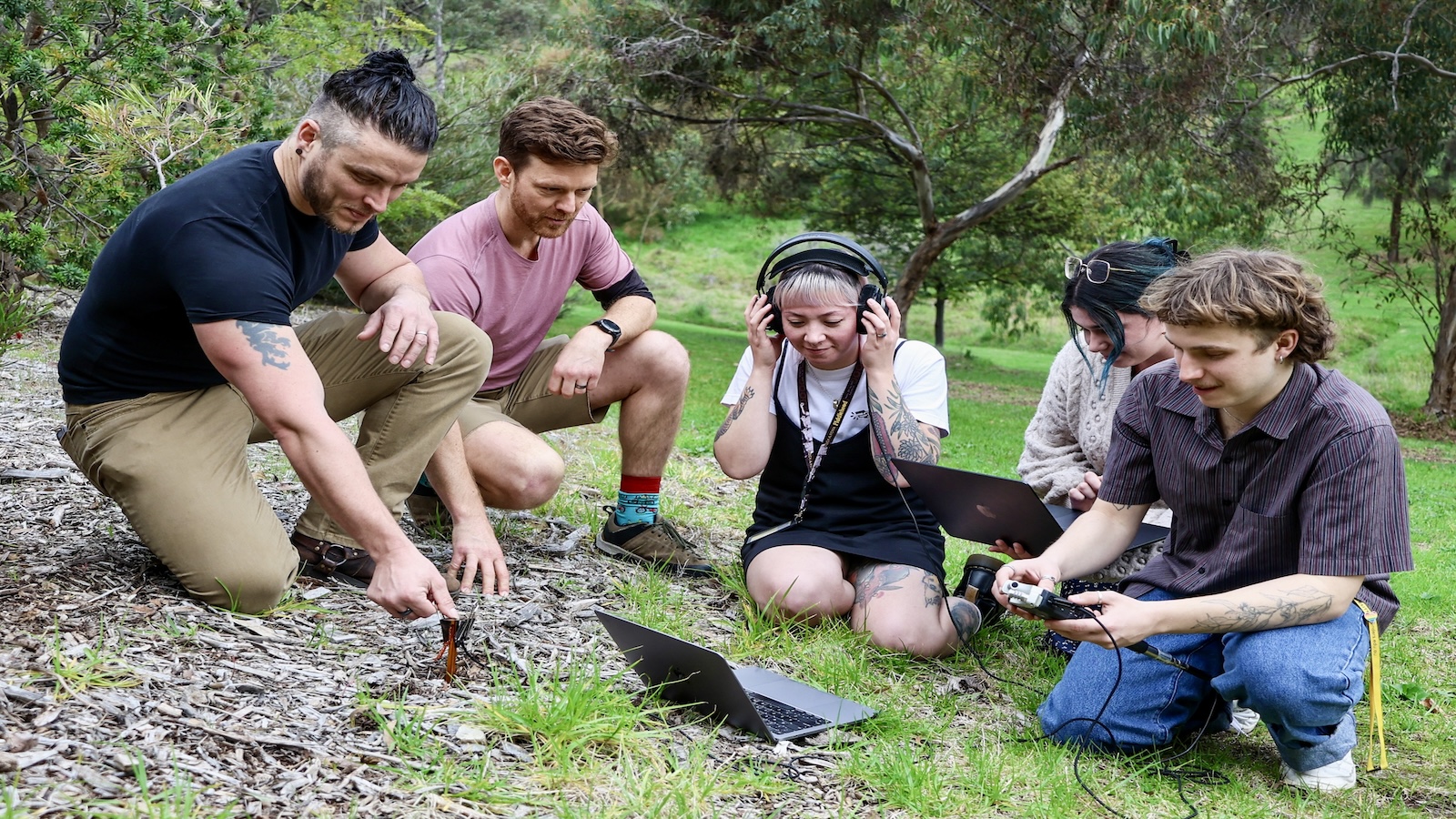
Think back to the last concert you went to. Now replace the music that was ringing through the venue with an erratic series of pops, muffled staccatos, distorted taps and sudden clicks. No one sound is completely distinguishable from the other, everything blends together in a jumble of unsynchronized noise.
Except, instead of musicians, what you hear is a mass of subterranean invertebrates. And they put on an unorthodox show for the handful of people who know where and how to tune in—a complex symphony of vibrations and pulses that echo the condition of the very soils in which these organisms move.
“You can actually use sound to listen to the soil, and get an indication of soil health based on the little critters moving around,” said Jake Robinson, a microbial ecologist at Flinders University in Australia. He is the lead author of a study just published in the Journal of Applied Ecology found that ecoacoustics, or the study of environmental sounds, can not only be used to detect organisms in the soil, but can also be exploited to identify the difference between restored and degraded soil .
Although the practice of recording the sounds of nature has existed for over a centuryusing those surveys to analyze ecosystem health is a newer discipline. In recent years, scientists have begun experimenting with using ecoacoustic tools to capture the full range of sounds in healthy ecosystems—as in coral reefs, cavesand oyster beds — and applying those surveys to recovery efforts in damaged and degraded areas.
And yet soil, and the many hidden species and organisms that exist underground, were not considered for such techniques. Until now.
“People in the past thought that echoacoustics probably couldn’t be used for that because there’s no vocalization or echolocation. We’ve shown that it can actually be used,” Robinson said. The trick, he noted, is to deploy sensitive enough microphones that allow you to detect the most minute movements. “Things like centipedes, the little scratchy legs, you can compare them to a worm, [which has] more of a sliding action. So actually you can see slight differences between the acoustic profiles of these little animals.”
From centipedes to nematodes, soil around the world teems with billions of living organisms that make up the Earth’s biosphere and contribute to the global food supply. All told, the ground under our feet houses the most biodiverse habitat on the planet. “The more invertebrates there are in the soil, the more active they are, the more different sounds and vibrations they emit,” Robinson said.
His team used an underground sampler and sound chamber to record and collect 240 ground acoustic samples from deforested plots, sites being restored, and those with at least some of their original vegetation in a corridor of grassy woodland in Mount Bold, South Australia. After first listening to the acoustic recordings in situ, and then removing soil samples to analyze them in controlled conditions in the field, they discovered a pattern: The acoustic complexity and diversity of the soundscapes were significantly lower in the deforested plots .
Lack of diversity in a soundscape indicates that life is lacking underground, so the soil is likely to be in a state of degradation, meaning that they experience physical, biological and chemical losses in quality. Degradation causes significant decline in biodiversity, which hampers soil’s essentiality ecosystem servicessuch as pedal boating, and lead to colossal consequences for the world’s agricultural productivity, limiting crop yields and livelihoods. This is a problem that more than three quarters land on earth. “It could rise to 90% by 2050 unless we act,” Robinson said, according to a warning issued by the United Nations Food and Agriculture Organization in 2022. “We have to do something.”
Unsustainable land management, intensive farming practices, urbanization and anthropogenic climate change can disturb and damage land, causing degradation; which in turn affects how much carbon soil has the capacity to store.
Degradation also creates a negative feedback loop for many soil species, reduce their chances of survivaland the soil further deteriorates. This is because these soil organisms themselves are key to maintaining soil health, so their presence is not only an indicator of soil viability, but also helps create that viability. Earthworms in particular increase global food production, contributing to the growth of more than 140 million metric tons of food each year by increasing vegetation and enriching soils. (If earthworms were a country, they would the fourth largest grain producer.)
In fact, in many parts of the world, the counting of earthworms is commonly deployed by farmers to measuring soil healthbut those measurements are not always accurate. “Everything has its place in ecosystem ecology. So if you only measure one thing, you miss other parts,” said Victoria Burton, a postdoctoral researcher studying soil biodiversity at the British Natural History Museum. One example is that in areas where earthworms are invasive, you’re likely to find many of the invertebrates in degraded habitats, making the number of their abundance a poor measure of healthy soil. This strengthens the case for widespread application of soil acoustics for more accurate readings in agricultural and conservation contexts, she said.
Burton added that this research is the first of its kind to show how ecoacoustics can be used to identify soil health specific to the grassy woodland ecosystem – a study released last yearalso led by Robinson, found similar results when measuring soil biodiversity in Britain’s temperate forests – but she has questions about how this technique would perform in other ecosystems. However, she is excited about the prospect: Her team is installing acoustic ground sensors in the museum’s gardens to better monitor changes to urban wildlife in space.
Scientists don’t just listen to subterranean realms for classification purposes. They are also using acoustics to see if they can speed up the recovery process, according to Robinson. “The vision, I think, is to see if degraded lands can be played sounds that help them recover,” he said.
In another upcoming study, his team discovered that when they played certain sounds to a type of fungus called Trichoderma, widely used in agriculture to protect crops from disease and improve plant health and replanting, it effectively stimulated organism growth. Of course, this result is preliminary, but it offers great implications for how eco-acoustics can be applied to degraded soil on agricultural land. Monitoring soil health through soundscapes can be used by farmers and producers to find out where they need to intervene preventively. And playing back healthy soil surveys in eroded patches could, in theory, encourage that beneficial fungal growth, restoring recovery.
As with any research in its infancy, just how this technology will be applied, and what degree of impact the use of eco-acoustics may have in efforts to restore degraded soils, remains up in the air. The biggest uncertainties revolve around how different soil types and properties might affect sound transmission underground, in addition to how this technique might perform in other ecosystems and geographies.
As researchers work to find the missing pieces, the natural symphonies found in the ground begin to attract attention from unlikely sources. Last year, a composer in Norway reached out to Robinson with an unusual request: She wanted to incorporate sounds emitted by earthworms into one of her orchestral productions.
“It’s quite interesting to hear a centipede that has small legs. It’s like a little hairy, high-frequency tapping sound. Then, for example, a snail, which is like a slow, slimy, sliding-like sound, and the worm is something in between,” Robinson said. “It’s like listening to Mother Earth, isn’t it?”





